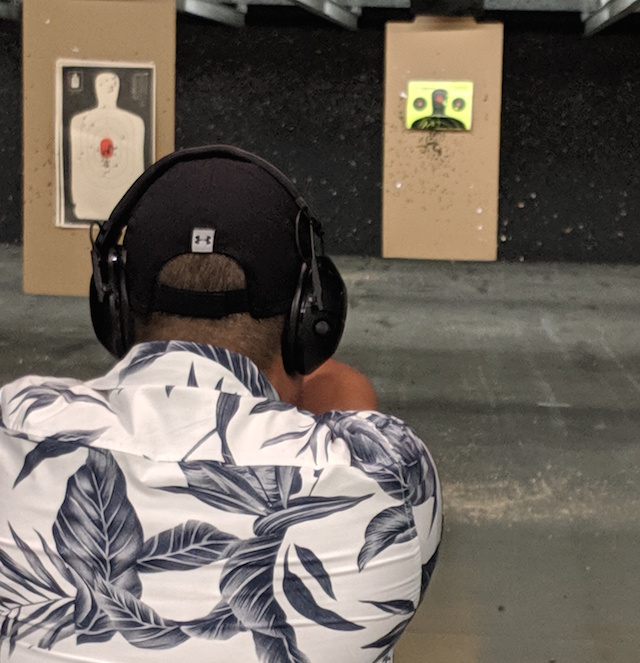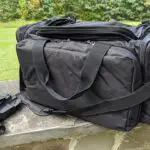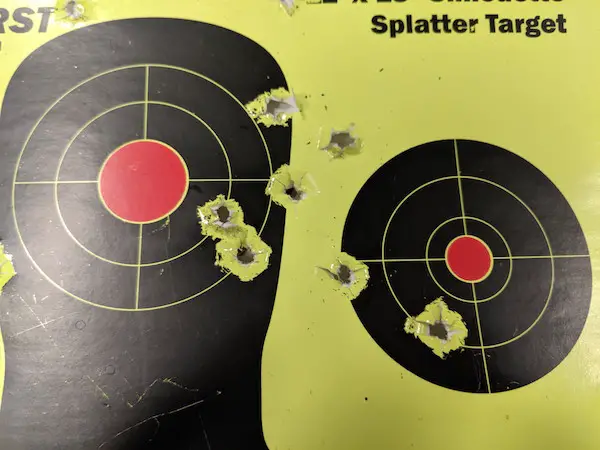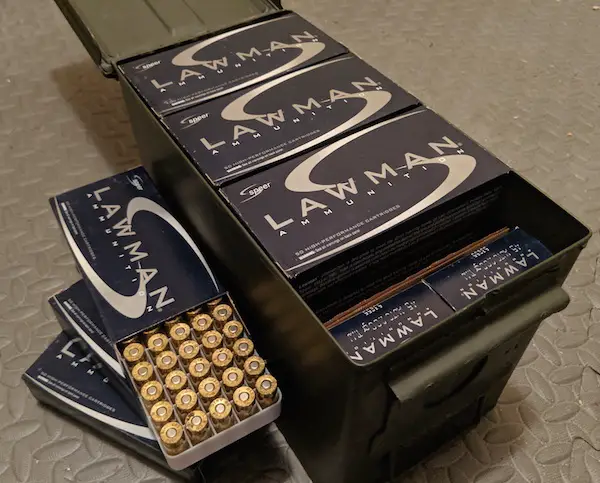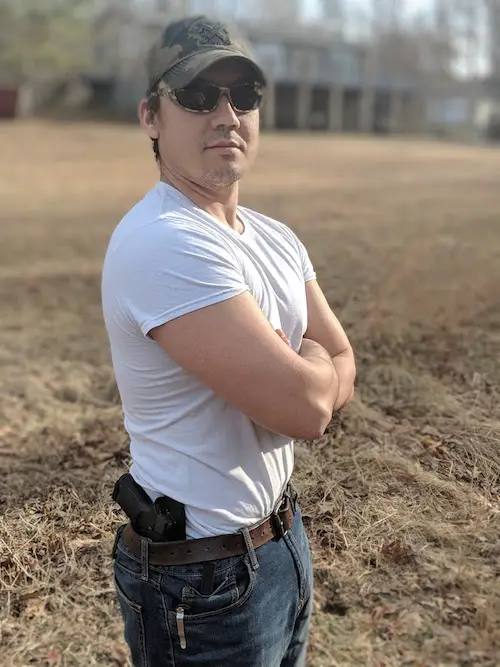Participating at your local shooting range is a great shooting experience, particularly for first time shooters. However, there can be a lot of questions flooding the new shooters mind before they even arrive at the range parking lot. Is the shooting range safe? Can I rent a gun or do I have to bring one? What should I be wearing to shoot? These are just the tip of the iceberg, so I’ll do my best to provide a thorough answer to many of the questions I’ve been asked, and had myself on occasion. Whether you’re a seasoned shooter, or this will be your first time stepping onto the shooting lane, here’s a comprehensive list of the things you need to know about your first trip to the shooting range.
Table of Contents
Safety First: Is The Shooting Range Safe?
“Is the shooting range safe?” This is the first question that is likely to surface in any new shooters mind. Shooting ranges are one of the safest places to shoot. First, many shooters are seasoned and well trained. Any beginning shooter almost always arrives with someone who has experience handling firearms, and that person has undoubtedly instructed the beginning shooter on basic firearm safety. Finally, there is an added layer of protection at the shooting range, in the form of the range master. Furthermore, facilities are designed to promote safety, and often must meet strict guidelines for operation.
Of course, there is the off chance that a first time shooter will break one of the rules regarding firearm safety. The range master will be quick to reprimand, and then instruct, any user who violates range safety or the proper protocol. Shooting ranges are as concerned, if not more so, about range safety as the patrons who walk through their door.
What Are The Rules At A Shooting Range?
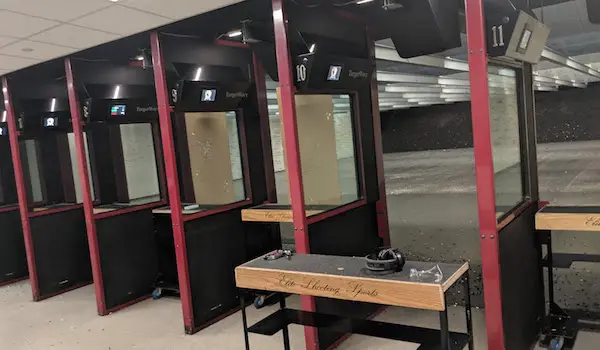
Every shooting range is different, while the rules may vary slightly, there are a core set of rules that almost never change. Here’s a rundown of the basic rules you’re likely to find at any shooting range:
- Exercise basic firearm safety (obey lane markings)
- Always keep the weapon pointed downrange
- Ear protection and eye protection required
- Always follow range master directions
- Range Entry/Exit Guidelines
1. Exercise Basic Firearm Safety
I won’t get into much detail about basic firearm safety here, but check out this article for more in depth coverage. Suffice it to say, that the weapon should only be handled by the shooter when occupying the shooting lane. Exercise trigger discipline, and only place your finger on the trigger when you are ready to shoot.
Additionally, it’s worth mentioning, that there are typically two lines on the shooting range floor for each firing lane. First is the line that denotes the shooters space. Second, you have the firing line. Or as I like to call it, the “do not cross if you want to live” line. ALL ranges I have been to denote the firing line. Sometimes, particularly at outdoor shooting ranges, the firing line is the only line denoted. If a shooters space is declared, only one person should occupy that space when weapons are hot.
2. Always Keep The Weapon Pointed Downrange
Once you uncase or unholster your weapon, it should remain pointed downrange. In case you’re unfamiliar with the term, that means the direction you will be shooting. This is where your target will be, and is where the bullet traps are for the shooting range. Most importantly, there shouldn’t be any people in that direction. Always remove your weapon from the holster or case, once you are in the lane. Do not remove it beforehand and carry it to the shooting table.
Some places are a bit more stringent than others when it comes to this hard and fast rule. For instance, I’ve been told by a couple range masters that even when the weapon is in condition 4, it should remain pointed in a safe direction. Other smaller ranges are a little more lenient when it comes to this rule. If it’s your first time at the shooting range, practice good habits and keep the weapon pointed downrange.
3. Ear and Eye Protection Required
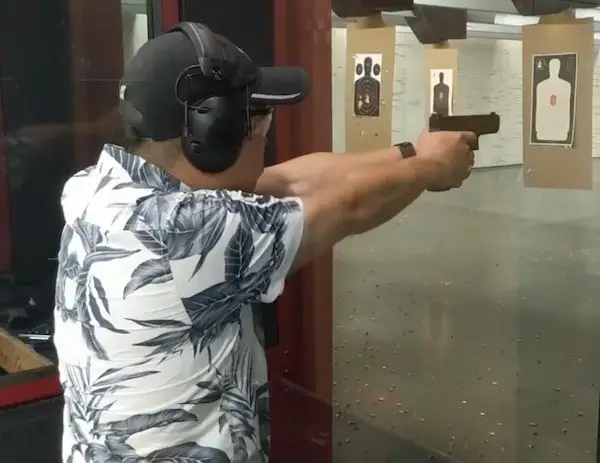
Sometimes referred to as “ear and eye pro” this refers to the ballistic glasses and noise reduction ear muffs required by shooters. Ranges typically provide basic glasses and ear muff style protection for their patrons. These won’t be the latest and greatest, so I recommend investing in your own ear protection if you plan to revisit the shooting range with any kind of frequency.
Occasionally, a shooting range will allow shooters to wear ear plugs in lieu of the ear muff style protection. However, I’ve never seen a range provide ear plug hearing protection. If you’ll be shooting extensively, it might be worth doubling up on your ear pro (plugs and muffs), also known as double-plugging.
If you’re looking for a quality set of ear pro, then I’d recommend the Peltor Sport Tactical 500 series on Amazon. When it comes to hearing protection on the range, Peltor is the top dog in the industry. I picked the Sport Tactical 500 up after testing my buddies Peltor ComTac III headset. However, I couldn’t afford the price tag on that version. So, I picked up the Sport Tactical 500, and am thoroughly impressed. I’ll do a full review in the recommended gear section later.
4. Follow Range Master Directions
While this rule seems mundane, and unimportant, it is vital to the first time shooters’ continued use of the shooting facility. Blatant disregard of range master instruction is a quick way to get tossed out of the shooting range.
Generally speaking, range masters are content leaving patrons alone while they are on the shooting line. However, if they see a violation of any of the range rules, or something that jeopardizes the safety of others, they’ll be sure to let you know. You’d be wise to follow their instruction, followed by a “Yes, sir” and “Sorry, about that I’ll be sure to remember that moving forward.”
5. Range Entry and Exit Protocol
On your first trip to the shooting range, you’ll discover very quickly that ranges are noisy places. One thing that often confuses first timer shooters is the entry and/or exit door setups. There is typically a set (two) sequential doors placed at the entrance of the actual shooting range. I want to make clear, I’m not talking about the entrance to the facility, which is typically a gun shop or other building. Instead I’m talking about the entrance to the range which is contained within the firearm store.
The double doors seem to be a bit of a puzzle to first timers, but I’ll explain their importance. When you enter the range to shoot, you are required to have ear and eye pro. Gunshots are extremely loud and can damage a persons’ hearing if they aren’t careful. Shooting ranges have a two door system to protect the hearing of those patrons in the waiting room. The first door must be closed before the second door is opened, to help muffle the acoustics from gun shots. You’ll know when someone has one of the doors open, as the shots fired on the range are audibly louder.
Some shooting facilities have a one way system, where one set of double doors is used solely to enter the range. A second set usually set on the opposite side of range is used only for exiting the range. This is the setup the NRA has for their shooting range. However, smaller facilities may use only one set of double doors. Keep an eye on patrons coming and going to ensure you won’t open the door while another person or group is in the enclosure waiting to leave.
Additional Rules That May Be In Effect
The above are the basic rules that every range I have shot at requires. However, depending on the location, there are a host of other rules that may be in effect at your local shooting range. Below are a list of additional rules that you should check on with the range master. Oftentimes, there will be a list posted for first time shooters and patrons, but it’s better to be safe than sorry.
- No photos or video recording
- Types of eligible targets
- Types of ammo restricted
- Calibers of ammo restricted
- Restricted shooting exercises
6. No Photos or Video Recording
This rule may seem a bit odd. But, depending on the type of patrons that frequent the facility, anonymity may be important. If a facility caters to military, law enforcement, or other government agencies, you’re more likely to encounter restrictions on taking photos or video recordings.
However, if you want to snap some pics, or take some footage of you and your friends at your local shooting range make sure you clear it with the proprietor of the establishment. Failure to do so may lead to any number of consequences, including expulsion from the shooting range.
While I’m on the subject of photos and videos at the range, do NOT take gun range selfies while on the firing lane. And NEVER get your friend to stand in front of you while pointing a weapon at them to get the perfect selfie angle. Blatant disregard of this will result in expulsion from the range, just ask these guys!
Obviously, the range I went to was kind enough to allow me to snap some pictures and video. However, please be courteous of those shooters around you who may be uncomfortable with being photographed or recorded. You never know if they are first time shooters who are camera shy or embarrassed. If there is someone in the adjacent lane, it’s always polite to ask them should they inadvertently be captured in a shot.
7. Valid Target Type
Another oddity of shooting range rules, some types of targets may be forbidden. Typically, the use of any likeness of a person is often prohibited. Therefore, if you’re a first time shooter thinking of stapling some pictures of your ex and unloading a few magazines into them, think again. While some shooting ranges are more lenient, it’s generally accepted that any human depiction (other than a silhouette) is prohibited as a target.
Oftentimes, the range will sell targets for you to use on site. However, I’ve generally been pleased with range operators being fine with shooters bringing their own targets. But, it’s worth calling ahead to make sure that you can bring your own target to the range.

8. Types of Accepted Ammunition
Rules regarding accepted ammunition should probably be under the general rules. However, because the variance is so great from range to range, I opted to include in the additional rules section. Generally, I’ve found that all ranges accept brass casing ammunition. The casing, is the part of the cartridge that houses the powder, primer, and bullet before firing. Once the round is sent downrange, the casing is what is ejected from the firearm. Steel casing is another common material, but it is not usually acceptable.
When it comes to the bullet (the actual projectile) you should avoid using hollow point ammo. Additionally, armor piercing rounds are almost never accepted. Beyond the question of legality in your area, armor piercing rounds can wreak havoc on bullet trap systems. Therefore, you’ll be hard pressed to find a range that allows you to shoot armor piercing ammunition.
Finally, you should check whether you can bring your own ammunition, or if you must purchase it through the shooting range. Even if you are allowed to bring your own ammunition, the range master or front desk attendant may ask you to present it for inspection. This is to ensure the rounds meet their requirements.
9. Restricted Ammo Calibers
It’s important to recognize that not all shooting ranges are created equal. Once you’ve been to a few, you’ll notice the differences. Everything from range lighting, to lane setup, to target retrieval, to the waiting room decor will indicate the elegance of the facility you’ll be shooting in. Therefore, depending on the type of range (indoor vs. outdoor) and what backstop features (rubber bullet trap vs. steel bullet trap) the range is equipped with, will determine the caliber of ammunition you’re permitted to shoot.
Many ranges may only permit the use of small caliber firearms, this would include your .22 lr up to a .45 acp. Other ranges will allow the use of rifle ammunition, where you can shoot up to a 7.62 or .308 round. You’ll need to check with the range before arrival to make sure that whatever caliber firearm you plan to shoot is not prohibited.
Occasionally a facility will have multiple ranges that are made to accommodate different caliber weapons (e.g. pistol vs rifle range). It’s highly likely that the range operator will inquire about the type of shooting you will be doing prior to collecting the range fee.
10. Restricted Shooting Exercises
While visiting my little sister a couple weeks ago, I was shocked to learn about some of the rules at the local range. You should inquire with the range master about restricted shooting exercises. While it may seem like no big deal to you to empty an entire magazine on that helpless paper target in under 5 seconds, “rapid fire” may not be allowed. For instance, at the range my sister and I went to, no more than two rounds could be fired in succession.
Furthermore, I had planned to work on drawing from my holster. Well, that went right out the window when I found out this shooting range did not allow drawing from a holster on the lane. Even if you’re allowed to practice drawing and firing your weapon, there may still be restrictions. Be clear about what you plan to practice, and clear it with the range master. If you’ll be using an IWB holster and drawing from behind your back, be sure to check that this method is acceptable.
Always check prior to beginning practice to make sure you don’t anger the range master. There’s nothing worse than worrying about a grumpy range master with his eye on you during your entire shooting session.
Shooting Range Etiquette and Best Practices
Thus far, we’ve talked about some of the written rules of the shooting range. Now, I’m going to discuss some of the unwritten shooting range rules. These items are more about being courteous to your fellow shooters, and good hygiene habits to get into. Shooting etiquette goes a long way with establishing a relationship with the shooting range, the range master, and your fellow shooters.
11. Clean Up Your Shooting Lane
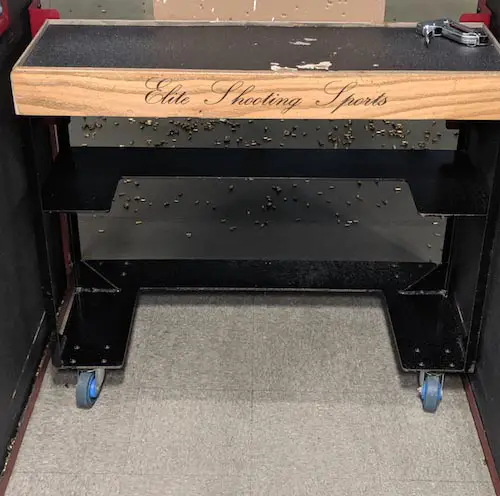
So, you’ve just finished putting 200 rounds downrange, and the floor is littered with spent brass. Well, nobody wants to sweep up your spent casings before they even get to fire their own weapon, so clean up your lane before leaving. It’s kind of like the old movie rental theme, of be kind, rewind. Basically, always leave your shooting lane in the same condition (or better) that you received it in.
This may require some extra work on your part, but it’s better than getting the stink eye and reprimanded from the range master. Put any shooting blocks and chair where you got them from. Sweeping up brass varies between shooting ranges. Some have you push the casings in front of the shooting line with a broom or squeegee. Others prefer you sweep up your brass and deposit into a bucket.
If you’re picking up your brass to use with your at home press, do so efficiently. Don’t spend time putting each casing into the 50 round tray. Bring a Ziploc freezer bag, and snag your ammo casings within your allotted lane time.
12.Watch Your Time
Speaking of time, it’s worth mentioning that you should keep an eye on the clock. Shooting ranges typically rent lanes by the hour. While the range master will be sure to remind you of when your hour is approaching its’ end, you should allow adequate time to clean up your shooting lane.
Of course, there is some wiggle room, and ranges typically don’t mind letting “regular” shooters go beyond the limit if the shooting range is slow on a given day. However, you shouldn’t rely on this and it is at the shooting ranges discretion whether to allow a shooter more time on the lane.
13. Three People Maximum Per Lane
Ideally, you will only ever have two shooters per lane. Obviously, these shooters will not be shooting simultaneously. However, on occasion, you may show up with an odd number in your shooting group. Rather than have the odd man alone on his own lane, you can insert a third shooter into your rotation. Alternatively, you could put someone by themselves on a shooting lane, but there is no guarantee that a lane will open up simultaneously and your group can shoot together.
However, fees are not generally reduced because multiple shooters are using one lane. At least that’s how it works with the NRA range. Two shooters is the ideal number, because while one shooter is loading their magazines, the other can be working on their groupings and putting rounds downrange. With three shooters per lane, you can have one spotter, someone reloading, and an active shooter.
14. Wash Exposed Skin When Leaving The Range
When you shoot, lead, carbon, and other particulates build up on exposed skin. Failure to rinse these upon exiting the shooting range can cause issues later on in your day. If you shoot consistently, prolonged exposure over time can lead to health problems. For this reason, when you leave the shooting range, hop into a bathroom and rinse off any exposed skin.
If you’re at a high end shooting range, they may have a wash basin, or other sink immediately available upon exiting the range. Take advantage of these facilities, to prevent ingestion of any harmful chemicals. Avoid touching your eyes, nose, or mouth until you’ve rinsed off.
15. Wipe Down Used Equipment (Ear and Eye Pro)
In the same vein, you should always wipe down borrowed equipment for the next user. Oftentimes, shooting facilities will have some type of disinfectant spray or wipe to use. I tend to clean off any borrowed equipment from the bins of ear and eye protection, if I fail to bring my own. Because I can’t rely on previous users having read this information, I err on the side of caution when it comes to borrowing range equipment.
What To Wear To The Shooting Range
Many people wonder about what to wear to the local range. First timers in particular don’t want to stand out any more than their shooting capabilities will already make them. You should always wear comfortable clothing, and shoes you can stand in for an extended period of time. Clothing that prevents spent casings from touching exposed skin is also recommended. For this same reason, I recommend closed toed shoes with a stable base.
For ladies, this means not halter tops or low cut shirts on the firing line. Unless of course you like the feel of hot brass against your chest. Yoga pants, jeans, or other full leg pant should be sufficient. Both guys and girls should avoid wearing flip flops or sandals. I recommend that women do not wear shoes with heels, even if they are closed toed. All it takes is to land that heel on a spent casing and you’re firing into another persons lane accidentally, and probably rolling an ankle.
If you plan to work on drawing your weapon and firing it, then bring an acceptable holster to the range. You’ll need to check in advance for acceptable carry and draw methods for this.
Does the Range Loan or Rent Weapons?
If you’re wondering, “does the shooting range rent weapons to people?”, you better call ahead and ask. Most ranges do not rent weapons. Other shooting ranges will loan firearms to patrons to use on the range. Obviously, you shouldn’t expect any firearm rental to be free. However, I have heard that some shooting ranges will allow you to exchange one firearm rental for another gun. The fee for renting a gun will depend on the shooting range, and type of firearm. A local shop near me will rent a gun to a patron for $10 (in addition to range fees) and offers the option to swap for a different weapon.
Typically, ranges that rent you a firearm will require that you purchase the ammunition to fire the weapon from them. They may also require you to purchase any targets through them, but that’s not as common. Ideally you’ll bring along a friend who has their own firearm so you’re sure to have a gun to shoot. Furthermore, they’re likely to have their own ammunition and targets. But, to be on the safe side, make sure that you are permitted to bring your own shooting supplies by calling ahead or checking with the attendant running the range.
If you’re looking to try out a new weapon, check to make sure they even have that gun as a rental. Of course, if you’re just shooting for sport, you can ask about things like silenced firearms or fully automatic rifles. The range will need to have a class III license to even have these weapons, but it’s worth asking!
Is There An Age Limit For The Shooting Range?
I have not encountered a shooting range with an age limit. However, it’s worth checking local laws about providing a firearm to minors. As long as you are the parent or legal guardian, you should be able to bring a minor to the shooting range. The range safety officer, or perhaps even the register attendant, may inquire and tell you if minors are not allowed to shoot. If you have any doubts check with the range first. This is particularly true for states where firearm laws are more restrictive.
Is There A Test To Use The Shooting Range?
Generally, there is not a test prior to using a shooting facility. However, certain ranges may require that you provide proof of familiarity with a firearm as a condition for using the range. Alternatively, there may be a range safety video you are required to watch before being permitted to use the facility. Sometimes a concealed carry permit will suffice for evidence, but this is determined by the individual range.
If you’re worried about passing any quiz for using the firearm range, I recommend you familiarize yourself with basic firearm safety, here. Additionally, formal training with live fire exercises may be beneficial, but generally not necessary. You’ll learn about topics like sight alignment and common firearm failures.
How Much Does A Trip To The Range Cost?
If you’re looking to take a trip to the local shooting range, you can expect to pay between $25-$40 for your shooting lane. Shooting ranges charge by the hour, and these fees do not include gun rentals, cost of targets, or ammunition. However, these fees should cover basic ear and eye protection for use on the shooting range. So long as you don’t destroy any property (e.g. target retrieval systems, acoustic barriers, baffling, etc.) this is what you should expect to pay for an hours’ worth of range time.
However, some ranges require that you use ammo sold on premises at their shooting range. Traditionally, these places have a markup on the cost of ammunition, and generally do not offer bulk pricing discounts. Therefore, you’ll need to factor this into your cost, or find another shooting range. In addition, ranges often sell ammunition, targets, gun lubricants, and other firearms related items at an additional fee.
Getting Discounts At The Shooting Range
Although the cost for a lane may seem steep, some shooting ranges offer various discounts. Many ranges will offer discounted hourly rates for law enforcement or military personnel. If you have a friend who fits into one of these categories it’s worth bringing them along.
Additionally, some ranges have “membership” pricing that allows members to purchase lane time at a discounted rate. I’ve even had ranges offer discounted pricing for those with a concealed carry permit.
Finally, if you are a concealed carry permit holder, you may be eligible to rent a lane at a discounted rate. Although the cost to obtain a concealed carry permit will vary from state to state, it is worth getting your license if you plan to visit the shooting range frequently.
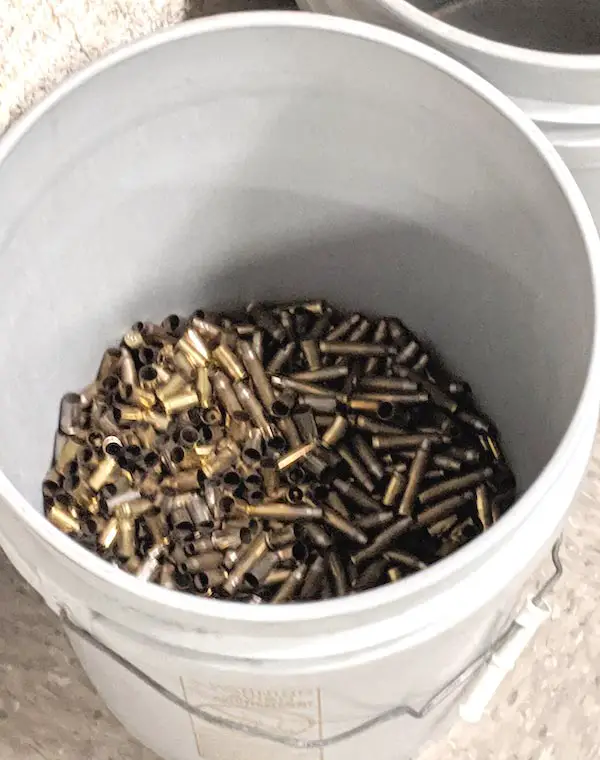

How Many Rounds Should I Bring/Shoot At The Range?
New shooters often wonder how many rounds they should bring to the shooting range to get comfortable with their weapon. Bring 100 rounds with you to the shooting range, and assess your comfort level as you progress. Your 100 rounds should be per caliber (e.g. 9mm, .380, etc.) you intend to shoot. At a minimum you should put 50 rounds downrange. If after putting 100 rounds into the backstop you are still uncomfortable with a particular caliber, or shooting in general, you’ll know.
Obviously, the level of comfort will vary from shooter to shooter. But this amount of ammunition should give you a good idea of whether shooting is something you enjoy and should pursue. You’ll by no means be an expert marksman at the end of that 100 rounds. However, if you take your time with each shot and focus on the basics of marksmanship, you’ll leave much more proficient than when you arrived.
Parting Shots
Remember, that each range is different, and therefore subject to different rules. However, if you abide by the range masters’ instructions, and practice safe handling of firearms, you’ll generally be alright. For your first trip, make sure you are wearing comfortable clothing and shoes, that minimize exposed skin. Ideally, you’ll have a seasoned shooter accompany you to the range, to provide a weapon to shoot, in case the shooting range does not rent weapons. For any information or concerns you may have, it is best to contact the shooting range in advance.
Hopefully, this article has provided insights into what to expect when you first visit the shooting range. If you found this article helpful, check out some others, or contact us to receive alerts about new information.
